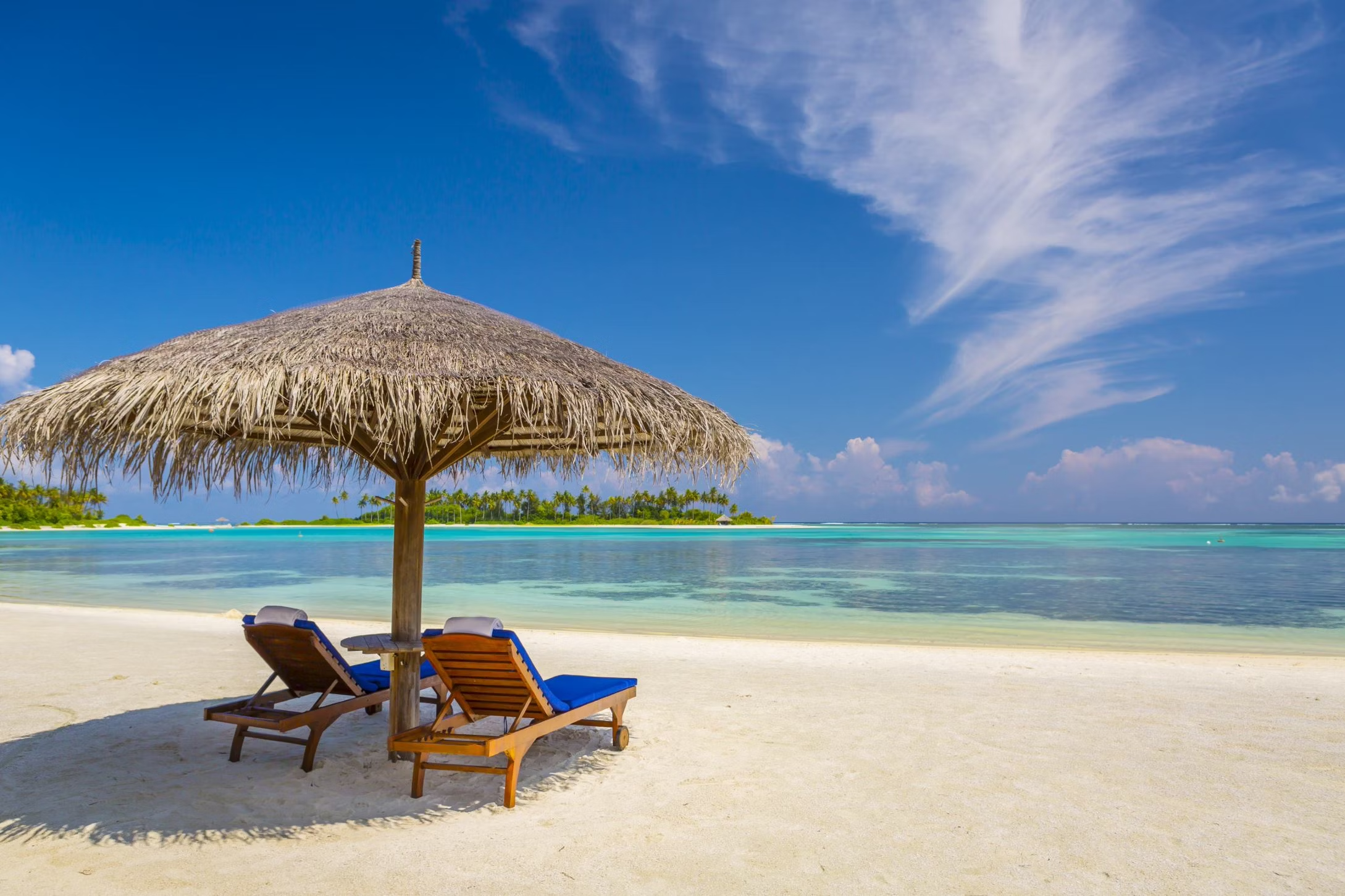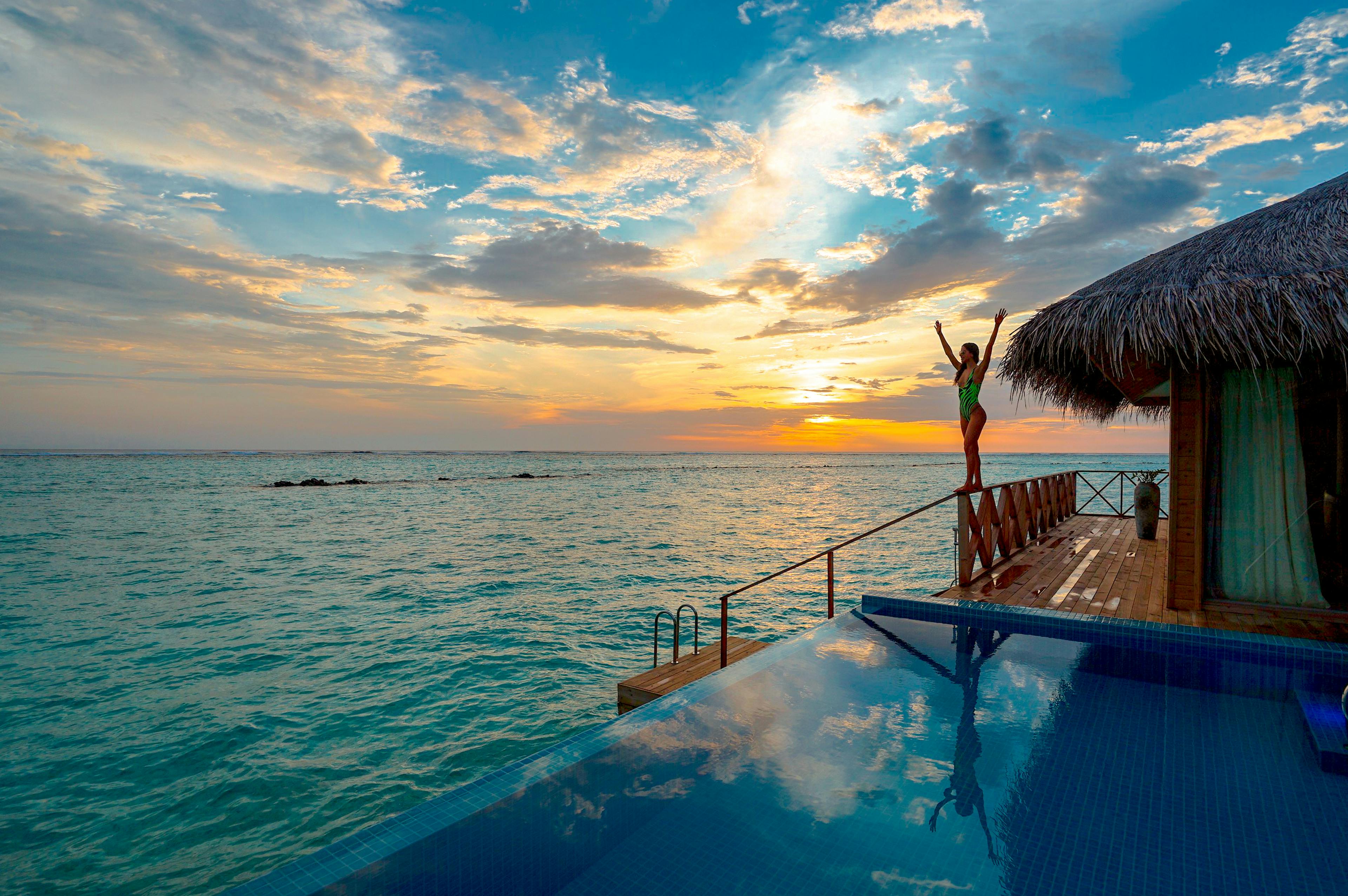When people picture the Maldives, images of overwater villas, turquoise lagoons and palm-lined beaches instantly come to mind. But beyond its postcard-perfect beauty lies a fascinating island nation full of surprising stories, deep traditions and natural wonders waiting to be discovered.
Whether it’s your first visit or your fifth, learning more about the Maldives will give your journey extra meaning. From ancient navigation methods to world-record marine life, these fun facts reveal what makes this Indian Ocean paradise unlike anywhere else on Earth.
Quick Trivia About the Maldives
- The Maldives is made up of around 1,200 islands across 26 coral atolls, yet only about 200 are inhabited.
- It holds the title of the world’s flattest country, with an average ground level of just 1.8 metres above sea level.
- The islands’ brilliant white beaches come from coralline sand, not quartz, making them among the rarest in the world.
- The dhoni, a traditional Maldivian boat, was once navigated solely by reading the stars and lagoon currents.
- Five of the world’s seven species of marine turtles can be found in Maldivian waters, alongside whale sharks and manta rays.
1. The World’s Flattest Country
With an average elevation of just 1.8 metres above sea level, the Maldives is officially the world’s flattest country. Its highest natural point, on Villingili Island, rises only 2.3 metres above the ocean.
This low-lying geography creates postcard-perfect horizons where the sea seems to meet the sky. It also means the islands are constantly reshaped by tides, waves and coral growth, a reminder of how closely Maldivians live in rhythm with the ocean.
“Flying into Malé was breathtaking. It looked like someone scattered emeralds across a sheet of blue glass.” – Daniel S., 2023
2. A Nation of Coral Islands
The Maldives is made up of 26 atolls and around 1,200 coral islands, stretching across 870 kilometres of the Indian Ocean. Only about 200 islands are inhabited, while another 100 are home to resorts.
These atolls are ancient coral reefs formed around the rims of submerged volcanoes. Over millennia, coral growth created the ring-shaped structures that now define the country’s geography.
3. True White Sand Beaches
Not all “white sand” beaches are equal. The Maldives’ sands are made of coralline material rather than quartz, giving them a brilliant, pure white colour found on only about 5% of beaches worldwide.
The fine texture keeps the sand cool, even in the midday sun, perfect for barefoot strolls along the shoreline.
4. A Climate of Two Seasons
The Maldives enjoys a tropical monsoon climate with two main seasons:
- The northeast monsoon (December to April) brings dry, sunny weather ideal for beach holidays.
- The southwest monsoon (May to November) brings occasional rain and wind, but also lush greenery and quieter resorts.
No matter when you visit, temperatures stay around a pleasant 28–31°C year-round, making the islands perfect for Maldives holidays any season.
5. A Haven for Whale Sharks
The Maldives is one of the world’s best destinations to see whale sharks, the gentle giants of the sea. The South Ari Atoll is particularly famous for year-round sightings, where snorkellers can swim alongside these majestic creatures measuring up to 12 metres long.
Responsible tourism initiatives ensure that encounters are respectful and sustainable, protecting the species for future generations.
6. A Sanctuary for Sea Turtles
Five of the world’s seven marine turtle species thrive in Maldivian waters — hawksbill, green, loggerhead, olive ridley and leatherback turtles.
Visit nesting sites such as Laamu Atoll or the Baa Atoll Biosphere Reserve, a UNESCO-listed area where conservation projects invite visitors to learn about marine ecology and coral restoration.
“Watching baby turtles make their way to the sea at sunset was easily the highlight of our trip.” – Sophie L., 2022
7. Traditional Boats Without Compasses
The Maldivian dhoni is an elegant, handcrafted wooden boat used for fishing and island transport. Traditionally, sailors navigated without compasses or GPS, instead reading the stars, tides and lagoon currents.
Modern dhonis may use engines today, but their curved hulls and craftsmanship remain symbols of the nation’s maritime heritage.
8. The Coconut Tree: A National Symbol
The coconut palm is the national tree of the Maldives and plays a vital role in island life. Every part of the tree is used, from coconut milk and oil in Maldivian cooking to fibres for rope and leaves for roofing.
You’ll even see the palm featured on the national emblem, symbolising resilience and abundance.
9. Home to Ancient Coral Houses
Before concrete became common, many traditional homes and mosques in the Maldives were built using coral stone harvested from shallow reefs. These porous blocks kept interiors cool in the tropical heat.
Today, coral mining is banned to protect reef ecosystems, but you can still see examples of coral architecture at the Old Friday Mosque in Malé, one of the oldest surviving coral stone buildings in the Indian Ocean.
10. The Boduberu Beat
Music and dance are at the heart of Maldivian culture, and the lively Boduberu tradition is a must-see. Performances feature rhythmic drumming, singing and dancing that start slowly and build to a powerful crescendo.
The drums are made from coconut wood, and the songs often tell stories of love, seafaring and everyday island life. Many resorts host Boduberu nights, offering travellers a chance to join the dance.
11. Fridays Are the Weekend
In keeping with Islamic custom, the Maldivian weekend falls on Friday and Saturday instead of Saturday and Sunday. Friday prayers are a significant weekly event, so some shops and offices close in the afternoon.
Tourists should keep this in mind when planning local excursions or visits to inhabited islands.
12. A Presidential Meeting Underwater
In 2009, former president Mohammed Nasheed and his cabinet made headlines for holding the world’s first underwater government meeting. Wearing scuba gear, they signed a declaration calling for global action against climate change, a symbolic reminder of the Maldives’ vulnerability to rising seas.
The event took place in the Girifushi lagoon and captured worldwide attention, reinforcing the country’s role as a voice for environmental sustainability.
13. A Sinking Paradise Fighting Back
Rising sea levels pose a long-term challenge, but the Maldives has become a leader in eco-tourism and marine conservation. Many resorts run coral-planting programs, ban single-use plastics and use solar power.
Guests can even join guided reef restoration dives, turning a holiday activity into a hands-on contribution to the islands’ future.
14. Islam: The Heart of Maldivian Identity
Islam is the official religion of the Maldives and has shaped the country’s traditions, architecture and community life since the 12th century. Visitors will notice the melodic call to prayer and see elegant mosques throughout the islands.
While alcohol and swimwear are permitted in resort islands, modest dress is expected when visiting local communities, a sign of respect for the culture.
15. A Nation of Endless Blue
The Maldives straddles the equator, giving it consistent daylight year-round. With sunlight striking the ocean at a direct angle, the sea here shimmers in every shade of blue imaginable, from sapphire shallows to deep indigo channels.
It’s this brilliant light that gives underwater photography in the Maldives its unmatched vibrancy. Bring reef-safe sunscreen and a waterproof camera to capture the magic.
Expert Travel Tips
- Plan around the seasons. For calm seas and sunshine, visit between December and April. For better rates and vibrant marine life, consider May to November.
- Respect local customs. Dress modestly when visiting inhabited islands and remove shoes before entering homes or mosques.
- Protect the reefs. Use reef-safe sunscreen and avoid touching coral while snorkelling.
- Pack light but smart. Bring sun hats, light cotton clothing and waterproof phone pouches for boat rides.
- Stay connected sustainably. Many resorts use desalinated water and solar power. Support these eco-friendly options when you can.
The Many Faces of the Maldives
Beyond its luxurious resorts, the Maldives is a country built on craftsmanship, faith and a deep respect for the sea. From bustling local islands to untouched sandbanks, every atoll tells a story of resilience and harmony with nature.
Travelling with Entire Travel Group allows you to see both sides of this paradise — the indulgent and the authentic. Our Maldives holiday packages include boutique stays, curated experiences and sustainable resort options to suit every kind of traveller.
Whether you’re gliding through lagoons on a dhoni or learning traditional drumming beneath the stars, the Maldives offers more than just beauty. It offers connection.
References
Experience the Maldives with Entire Travel Group
From coral atolls to turquoise lagoons, every island in the Maldives offers its own version of paradise. But it’s the stories, people and traditions behind the beauty that make it unforgettable.
Let Entire Travel Group take you beyond the postcard views with
thoughtfully designed packages
that blend relaxation, adventure and cultural discovery.


